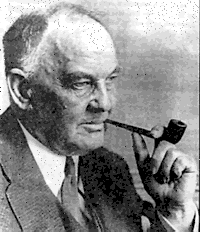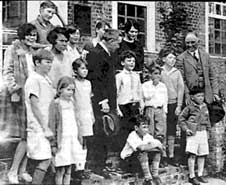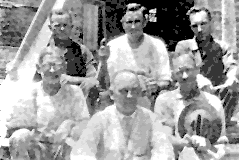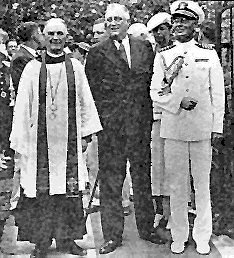History of the Restoration
"My Dream and My Hope"
by Edwards Park
Life's mission to preserve Williamsburg
His quest to save Williamsburg consumed W. A. R. Goodwin's life. An interview with his son Howard reveals the man and his time.
He had a way of warming a room when he entered it. He was a big man, bursting with health and enthusiasm, speaking always with grace and wit. A pipe was generally in his hand if not between his teeth. It was part of him — provoker of ideas, emphasizer of words, soother of mind. "Whenever he leans back in his chair, pulls out his pipe and starts packing in the tobacco," said a fellow minister, "the rest of us are aroused in anticipation of vigorous and humorous discussion, led by the Doctor and his gesticulating pipe."

"The Doctor" was William Archer Rutherfoord Goodwin, twice rector of Bruton Parish Church, and department head at the College of William & Mary. Without the Doctor, the ancient and magical city of Williamsburg would likely be just another truck stop, a neon-lit nubbin of fast fooderies on the string of roaring highways linking Richmond to the Hampton-Newport News complex. Goodwin, with his steadfastness and sunny charm, made his remarkable pipe dream of restoring the old colonial capital come true, and so became a leading player in Williamsburg's drama.
Role of modest Goodwin not well known
Williamsburg's hordes of aficionados know the tale of the city's renaissance at least as well as their catechisms: John D. Rockefeller Jr.'s interest in the old city and how it bloomed into the incredible generosity that financed the restoration. But Goodwin, the man who had long dreamed of rescuing the former capital and who brought Rockefeller's interest to a boil, remains less known to the public — which is just as he would have wished.
Though part of his family tree was rooted in New England, W. A. R. Goodwin was thoroughly Virginian, the son of a wounded Confederate captain who returned from grim warfare to grinding destitution. The father hardscrabbled a farm in hilly Nelson County to keep his family alive. The lad, born only four years after Appomattox, soon knew that only hard work could lead him to a better life.
"First book I ever bought," reads the inscription inside the cover of a fragile volume, "with the money secured by working four days in the cornfield in Nelson County near Norwood." Date: September 1885. That was the 16th year of the buyer, W. A. R. Goodwin. Now his son, E. Howard Goodwin, hands me the book from his crowded shelf, and I take it gingerly to read the title: Buried Cities Recovered.
A visit with Goodwin's son
I called upon Howard in Charlottesville on a late winter day and received that seemingly effortless hospitality that marks old time Virginians: He met me, drove me to his home, sat me in a comfortable chair for a talk about his father, took me to lunch, then sent me on my way. I left with a sense of friendship for this quiet, thoughtful man.
Now in his early 70s, Howard is a fit, husky man (he played football for the University of Virginia) with the same strong face that photographs of his father reveal. He's the oldest child of William Goodwin's second marriage, so his memories only go back to life in Rochester, New York, where his father was pastor from 1908 to 1923. "I have a childhood memory of enormous heaps of snow," says Howard. "That's my total recollection of Rochester. After all, I was only four when Father was asked to return to Williamsburg to set up a new endowment fund at William and Mary. The first one had been cut off by the Revolution, and the second by the War Between the States."
For Dr. Goodwin, the return to Williamsburg was a happy homecoming. He had first visited the old capital 30 years before when, fresh out of the Virginia Theological Seminary in Alexandria, he gave a talk to William & Mary students about going into the ministry. In 1902, he gladly accepted the position of rector of Bruton Parish Church.
Goodwin not first to want to restore colonial capital
To say that Dr. Goodwin was first to dream of restoring Colonial Williamsburg would be wrong. Dozens of townspeople, aware of their proud history, had thought of such a thing. But the task was too great and far too expensive to take seriously. By the turn of the century, many old houses had been embellished with Victorian porches; others were quietly rotting away with tottering walls and sway-backed roofs. Chickens scuttled out of the ruts in Duke of Gloucester Street as oxcarts creaked past, churning it into deep mud or thick dust, depending on the weather.
Yet from every twisted shade tree, from every mossy, sagging fence, the past cried out to those who would listen. Here was where Colonel Washington trotted toward the Governor's Palace to discuss the exploration of western lands with Lord Dunmore. Here was where young Tom Jefferson strolled to Raleigh Tavern for a little jollity in the Apollo Room, only to be spurned by his fetching "Belinda." Dr. Goodwin was one of many who heard the call of the "glad and gallant ghosts," as he described them. Unlike the rest, he acted.
"Father was a good historian, a fine antiquarian," says Howard Goodwin. "He had great powers of persuasion and knew how to use them. He was charming and popular."
Even as a lad at Roanoke College, the elder Goodwin was given a walking stick with a gold head by friends. Their names are inscribed on it. Howard showed it to me — darkly gleaming wood topped by bright gold — an unusual gift between college students, obviously inspired by strong friendship.
Bruton Parish Church restoration
During his first pastorate at Bruton Parish Church, Goodwin honed his great weapon —skillful, persistent, ever-delightful urgency — to raise money for its restoration. He needed all the help he could get to rouse the support of his parishioners. This was the town, after all, that once forgot election day (and was hilariously twitted for it by the Richmond Times-Dispatch: "who will care to live in bustling Richmond or New York when he can dwell in the everlasting Sabbaths of Lotusburg?").
Against odds, Goodwin scraped together enough contributions to start restoring the church in 1905. The original design had been altered by "innovations" made in 1839, and his plan was to get rid of these. Still, some conservative parishioners hated the idea of his fussing with their church, so to pacify them and also bid an official farewell to the interior arrangement that they knew, the rector arranged a special service on the Sunday before work was to begin.
Special Service held prior to restoration work
Goodwin himself wrote the story of the service:
The old organ which had come down from Colonial days had undergone many local repairs. Parts of it had been tied together with wires and parts with shoelaces. . .
When . . . the organist put her fingers upon the keyboard to play the opening hymn, the organ gave a long and horrible moan — and passed into eternal silence.
This was the beginning of horrors. A thunderstorm came up. A cat and dog took refuge under the Church, and began to dispute with each other the sole possession of this refuge from the storm. . .
Some of the conservatives hinted that it was all an omen of disaster and of divine disapproval.
Successful church restoration flames desire to continue
Despite that omen, restoration was successful, and indicated to Goodwin that his big dream — restoring the entire colonial capital — might be possible. He never forgot it during his 15 years in Rochester, and it was on his mind when he returned to Williamsburg with his new family in 1923.
The town had desperately tried to keep up with the 20th century, and its antiquities seemed doomed to become parking lots and cheap eateries. In the oxcart days of Goodwin's first residence, its rural funkiness had been at least interesting. But in the Model-T days, it had degenerated to grease-stained filling stations slapped together with sheets of corrugated iron. Utility poles paraded down the middle of Duke of Gloucester Street, sprouting skeins of overhead wires. A tin garage near the Magazine bore a sign reflecting the early '20's interest in King Tut: "TOOT-AN-CUM-IN."
Yet there were still enough early buildings to stir Goodwin's bounding enthusiasm. And he was encouraged by the success of his fund drive at William & Mary. Though his job at the college included heading up a new Bible study department, he collected funds for much-needed college buildings and persuaded President J. A. C. Chandler to hold off the restoration of the grand old Wren Building until architectural advisors could make it blend with his mental vision of a wholly restored city.
Son remembers father "always in a hurry"
"He was always in a hurry," says Howard Goodwin. "I remember walking with him down Duke of Gloucester Street when I was a little boy — having to trot to keep up. He had no time for strolling."
Either the fast pace, the endless meetings, or the heartfelt persuasion paid off — Dr. Goodwin was blessed with serendipity. In February 1924, the Phi Beta Kappa organization held a banquet meeting in New York to make plans for the honorary society's 150th birthday. Since the "Phi Betes" had started up at William & Mary, they asked Dr. Chandler to speak. Subject: "The College of William & Mary and Its Historic Environment."
Dr. Goodwin delivers speech at Phi Beta Kappa celebration in New York
"Jac" Chandler couldn't make the appointment. But he just happened to have on his staff the perfect substitute. William Goodwin set off happily for New York and pulled out all the stops in his speech at the banquet. And, by another stroke of serendipity, in the audience sat John D. Rockefeller Jr. "That was the beginning of the restoration," says Howard Goodwin.
Henry Ford not interested in restoration of Williamsburg
Yet at first, Dr. Goodwin failed to interest Rockefeller and turned to Henry Ford. A few letters tell that story.To Edsel Ford: "Seriously, I want your father to buy Williamsburg. . . ."He tried Henry Ford's brother, William. The only answer was a clipping from the Detroit Free Press: "HENRY FORD ASKED TO BUY ANCIENT VIRGINIA TOWN!"Answer: a form letter: "We regret that Mr. Ford's many activities are absorbing his entire attention. He is therefore, unable to interest himself in the matter mentioned."
To S. S. McClure, editor of McClure's Magazine, asking for help in getting Henry Ford's ear.
Answer: "My dear Mr. Goodwin: It is absolutely impossible under any circumstances to get Mr. Ford to do anything for anyone. That I know from long observation. Faithfully yours. . . ."
That kicked off a press "feeding frenzy," including an amusing editorial in the Baltimore Sun. Goodwin's answer was to ask the Sun's editor to come down for a visit "and I will prove to you, on the spot, that my dreams have foundations in fact!" The editor sent a top writer down, and the Doctor quickly won him over.

(In 1928, Goodwin (right) looks on as John D. Rockefeller, Jr., greets school children.)
Rockefeller family visits Williamsburg
But Goodwin's big chance came in March 1926 when John D. Rockefeller Jr. and his wife and five sons worked Williamsburg into their trip to Hampton Institute. Goodwin met them, escorted them around, and made friends, especially with David, the youngest Rockefeller son.
"David was about 11," says Howard, "closest to my age, so I was asked to tag along when Father showed them around the town. Father always liked David. That's why the telegraph code for Mr. Rockefeller became 'David's Father.'"
Rockefeller's expensive midnight stroll
When the Phi Beta Kappa Memorial Hall at William and Mary was dedicated that same year, Rockefeller attended the ceremony, then walked with Goodwin through the great trees behind Bassett Hall. They talked, and then Rockefeller asked to be left alone with his thoughts. After that visit, Rockefeller announced his intention to restore the old city. His moment of thoughtful solitude in the Bassett Hall woods has been described as history's most expensive midnight stroll.
It was in 1926 that Howard's father became rector for the second time of Bruton Parish Church. People often showed up wanting to get married in the famous old place, and Howard remembers being called from play by Mattie, the Goodwins' cook. She'd tell me to come home quick, get washed up, put on my shoes, and act as witness at a wedding."

(Goodwin (in light suit) is shown with workmen on the steps of the George Wythe House during its first restoration.)
Goodwin children played on streets of Williamsburg
Pre-restoration Williamsburg may have been an eyesore to the elder Goodwin, but all his children enjoyed playing there. Howard's half-sister, Evelyn, wrote a charming pamphlet, "What Williamsburg Means to Me," describing how she played among the tombstones of the graveyard with the only playmates available to a seven-year-old in the Williamsburg of 1903 — inmates of the asylum, well enough to be let out. Evelyn attended the old Matthew Whaley School, built over the foundations of the Governor's Palace. Because of that, she writes, she considered herself a princess.
Howard went to the same school. Though the Palace foundations were covered by the school, the foundations of the Capitol were in plain sight, and Howard and his young friends played cops and robbers amid this maze of ancient stonework. Another boyhood game was to run on top of the brick wall at the church. "The top was rounded, and my friends and I used to see how far we could run along it, barefooted, before falling off. We got so we could run the whole length."
When Howard got into scrapes, it was his mother who scolded him, not the Doctor. She had the knack of smoothly running her family around her husband, burdened and engrossed as he was. Looking back on his life with Father, Howard says there was not time for dad and the boys to play catch in the back yard. Yet he never missed it, except in retrospect. "We all knew Father was busy. He was important; we weren't. That was the way things were for most people, back then."
They used to go on vacations to Wytheville, in the hills. "Even then, Father would always be reading or writing," Howard recalls. But when the children put on plays under the trees, Goodwin would join other parents in coming to watch the fun, relaxing with his pipe. "Those were some of the few times he didn't work."
In Williamsburg, even mealtimes were seldom a break for Dr. Goodwin. His children ate early; he generally had a friend or business acquaintance for dinner. He never drank a cocktail. He never learned to drive. Despite his athletic build, he claimed no sport. "He sometimes played golf," his son recalls, "and I sometimes caddied for him. But he didn't play often, and I guess he was pretty awful." He remembers his father giving him a quarter at the end of one round of golf. "I didn't want a quarter. I was his son, not his caddy. So I slipped it back into his pocket when he wasn't looking."
As the children grew up, they went off to boarding school on ministerial scholarships, and their home life dwindled in importance. But as Howard grew older, he came to appreciate his half brother, Rutherfoord, who worked for the Restoration. The two became close, even though 18 years separated them.
Dr. Goodwin never a wealthy man
The extreme poverty of the Doctor's youth eased up, but he never became well-off and of course never profited from the Restoration, even though one of the world's richest men became his close personal friend.
"Because of his early poverty, he appreciated clothes and liked to look nice," says Howard. "He wore shirts with rounded collars and always a tie. In summer, he wore a seersucker suit, often rumpled."
One time the family's genteel poverty shook Howard. Returning to Williamsburg from Wytheville, Dr. Goodwin decided to break the journey at a hotel on Mountain Lake. Howard remembers the lobby: "…a beautiful fireplace, field stone, with cattle horns over it. I wanted badly to stay there. Father asked how much it would cost and, when told, he simply said, 'Sorry. We can't afford that,' and led us out. He never thought twice about it. It must have happened often to him. But I never forgot it. I was so embarrassed."
When Howard went into the steel business where clients were frequently entertained —lodged in the best hotels, given the best theater seats, driven around in chauffeured limousines — he always remembered that evening when there was no affordable room at the inn for his father's family.
Dr. Goodwin's long-time secretary, Elizabeth Hayes Goddard, kept a mountain of correspondence and notes about the beginning of the Restoration and is the source for much that we know about those crucial years in the '20s. Howard remembers that she always carried a court reporter's recording machine, and her fingers were constantly moving over its keys.
Among her memories of Dr. Goodwin was a meeting in Williamsburg with Thomas E. Tallmadge, a noted Chicago architect, two years before Rockefeller made his decision to finance the city's rebuilding. Tallmadge later noted his conversation with Goodwin in his book the History of Architecture in America:
Noted architect recalls meeting with Dr. Goodwin
"As we looked out over the somnolent village, glimpsing a colonial gable here and a filling station there, Dr. Goodwin said, 'My dream and hope is to make this town exactly as it was in the eighteenth century.''What?!'
He repeated it.
'But Doctor, how about all these war-time and modern buildings of various kinds?'
'We'll have to tear them down or move them off.'
'How many are there?'
'Over three hundred, anyway.'
'How many old houses would be left when you got through destroying the new ones?'
'About fifty-five but, of course, we would have to rebuild all those that have disappeared through the years.'
'How about the new concrete pavement in the Duke of Gloucester Street and the cement sidewalks everywhere?'
'Up they come.'
'And the telephone and telegraph poles and electric lighting standards?'
'Down they go,' said the Doctor.
In my astonishment I now played my trump card. . . . 'Well, the new high school will spoil everything, for you certainly can't tear that down.'
'Oh,' he said, 'that is where we'll rebuild the Governor's Palace.'
I laid my hand on his arm.
'Doctor, don't worry, get plenty of sleep and exercise and I'm sure you'll be all right in time.'"

(President Franklin D. Roosevelt, with Goodwin at Bruton Parish Church, visited Williamsburg in 1934 and dubbed Duke of Gloucester Street America's "most historic avenue.")
Few conversations could more clearly state the enormity of Goodwin's ideas and the trials of seeing them carried out. But carried out they were. In 1926, Goodwin bought the Ludwell-Paradise House on behalf of Rockefeller. The great work was underway.
Rockefeller helped pay Dr. Goodwin's medical expenses
Goodwin's long acceptance of burdens — at a breakneck pace — finally exacted its price. Failing health forced him to resign from his pulpit in 1938, after the Restoration was as finished as it seemed then it would ever be (though work still goes on in Williamsburg). Howard recalls that during his father's last illness, Rockefeller sent regular checks for $100 to help defray medical expenses. Goodwin gave his son hints of a deep faith that must have brought him comfort as he faced his last journey. "He once told me that in all his travels the most beautiful places he had ever seen were in his dreams. He indicated that he felt he would visit these dream places at the end of his life."
He died at his home in 1939, a few days after Hitler's troops stormed into Poland to start World War II. He had seen his great dream come true, and at last he simply needed a rest. Howard, in his sophomore year at the University of Virginia, left early football practice to come and see him as he lay in an oxygen tent. He brought his girl, whom he would marry in 1942. "I remember Father said some nice things to her. It was the only time she ever saw him."
Integrity and trust formed basis for friendship between two great men
"When Father died," he muses, "there were $39 left from the last check, so I sent it back to Mr. Rockefeller. He returned it to me, and told me to keep it." That small, quickly forgotten interchange perfectly reflected in a modest way the kindness, integrity, and trust that had always marked the relationship between the two men.
Rockefeller had a deep affection for the man who led him to spend millions and save a nation's heritage. He entrusted Goodwin to buy up properties without revealing the reason — which would have inflated prices. Goodwin managed to do so, yet retained his deep-seated, natural integrity. Greed never touched him. In today's cynical world, we can barely understand him, except to wish that such a person would again walk among us.
Triumphantly, he and Rockefeller mixed enormous means with boundless dreams. What a team they made.
